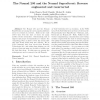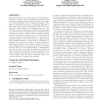3955 search results - page 21 / 791 » Comparing the Power of Robots |
ISLPED
2003
ACM
14 years 2 months ago
2003
ACM
Low power technology is impacting our society by creating the newly emerging digital consumer market, which leads to the nomadic life-style. In this paper, historical review of th...
JIRS
2006
13 years 8 months ago
2006
To safely and efficiently guide personnel of search and rescue operations in disaster areas, swift gathering of relevant information such as the locations of victims, must occur. U...
CEC
2009
IEEE
14 years 3 months ago
2009
IEEE
— It is advantageous for colony robots to be autonomous and self-sufficient. This requires them to perform their duties while maintaining enough energy to operate. Previously, we...
CRV
2006
IEEE
14 years 2 months ago
2006
IEEE
The Nomad 200 and the Nomad SuperScouts are among the most popular platforms used, for research in robotics. Built in the early 1990’s they were the base of choice for many mobil...
GECCO
2010
Springer
13 years 10 months ago
2010
Springer
Evolving multiple robots so that each robot acting independently can contribute to the maximization of a system level objective presents significant scientific challenges. For e...


